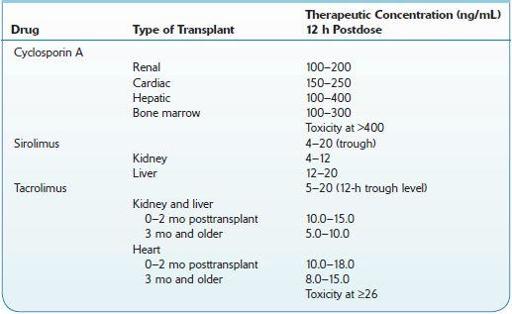Wallach's Interpretation of Diagnostic Tests: Pathways to Arriving at a Clinical Diagnosis (1014 page)
Authors: Mary A. Williamson Mt(ascp) Phd,L. Michael Snyder Md

BOOK: Wallach's Interpretation of Diagnostic Tests: Pathways to Arriving at a Clinical Diagnosis
9.72Mb size Format: txt, pdf, ePub
Sirolimus is a macrocyclic triene antibiotic that is produced by fermentation of
Streptomyces hygroscopicus
. Sirolimus was discovered from a soil sample collected in Rapa Nui, which is also known as Easter Island. Structurally, sirolimus resembles tacrolimus and binds to the same intracellular binding protein or immunophilin known as FKBP-12.
Tacrolimus is a macrolide antibiotic produced by
Streptomyces tsukubaensis
.
Other names: cyclosporine (Sandimmune, Neoral); sirolimus (Rapamycin, Rapamune), and tacrolimus (FK-506, Prograf).

Normal range:
see Table 16.46.
TABLE 16–46. Normal Ranges of Immunosuppressants Following Transplantation

Use
Cyclosporine is a drug that suppresses the immune system and is used to prevent organ rejection and marrow transplant. It is used in combination with other immunosuppressants or corticosteroids.
Although sirolimus was originally developed as an antifungal agent, it was later found to have immunosuppressive and antiproliferative properties.
Tacrolimus is an immunosuppressive drug that has been shown to be effective for the treatment of rejection following transplantation. Tacrolimus has been used for therapy of the following disorders: adult RA, as a single agent or in combination with methotrexate, adult refractory myositis, systemic sclerosis, Crohn disease, autoimmune chronic hepatitis, pediatric autoimmune enteropathy, uveitis, steroid-resistant nephrotic syndrome (severe), recalcitrant chronic plaque psoriasis, and atopic dermatitis (administered as ointment).
Limitations
Testing performed on whole-blood samples.
Clotted and/or frozen specimens unacceptable.
Testing performed by immunoassay or LC/MSn (multiple MS) technology.
Other books
Dolan's Cadillac by Stephen King
Extra Time by Morris Gleitzman
Dedicated Villain by Patricia Veryan
Zooman Sam by Lois Lowry
The Internet Is Not the Answer by Andrew Keen
Downfall by Rob Thurman
The Zebra Wall by Kevin Henkes
Hasty Tasty Low Carb Snacks & Appetizers by Claudia Jayson
The Judas Contact (Boomers Book 1) by Heather Long
The Abbot's Agreement by Mel Starr